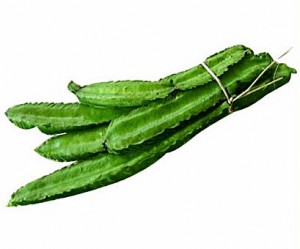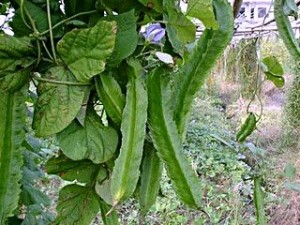 Winged bean (Psophocarpus tetragonolobus), also known as four-cornered bean, asparagus pea, goa bean, and manila bean, is a tropical legume plant and a native to Papua New Guinea. It grows abundantly in hot, humid equatorial countries, from the Philippines and Indonesia to India, Burma, Thailand and Sri Lanka. It does well in humid tropics with high rainfall. It is popularly known as “Sigarilyas” here in the Philippines and commonly use by Filipinos in many vegetables dishes.
Winged bean (Psophocarpus tetragonolobus), also known as four-cornered bean, asparagus pea, goa bean, and manila bean, is a tropical legume plant and a native to Papua New Guinea. It grows abundantly in hot, humid equatorial countries, from the Philippines and Indonesia to India, Burma, Thailand and Sri Lanka. It does well in humid tropics with high rainfall. It is popularly known as “Sigarilyas” here in the Philippines and commonly use by Filipinos in many vegetables dishes.
The winged bean plant grows as a vine with climbing stems and leaves, 3-4 m in height. It is an herbaceous perennial, but can be grown as an annual. It is generally taller and notably larger than the Common string bean. The bean pod is typically 15-22 cm long and has four wings with frilly edges running lengthwise. The skin is waxy and the flesh partially translucent in the young pods. Starchier and meatier than string beans, the flavor is similar but somewhat blander. When the pod is fully ripe, it turns an ash-brown color and splits open to release the seeds. The large flower is a pale blue. The beans themselves are similar to soybeans in both use and nutritional content (being 29.8% to 39% protein).
The plant is one of the best nitrogen fixers with nodulation accomplished by the soil bacterium Rhizobium. Because of its ability to fix nitrogen from the atmosphere, the plant requires very little or no fertilizers.
This bean has been called the “one species supermarket” because practically all of the plant is edible. The beans are used as a vegetable, but the other parts (leaves, flowers, and tuberous roots) are also edible. The tender pods, which are the most widely eaten part of the plant (and best eaten when under 1″ in length), can be harvested within two to three months of planting. The flowers are often used to color rice and pastries. The flavor of the beans has a similarity to asparagus. The young leaves can be picked and prepared as a leaf vegetable, similar to spinach. The roots can be used as a root vegetable, similar to the potato, and have a nutty flavor; they are also much more rich in protein than potatoes. The dried seeds can be useful as a flour and also to make a coffee-like drink. Each of these parts of the winged bean provide a source of vitamin A, vitamin C, calcium, iron, and other vitamins.
How to grow Winged Bean or Sigarilyas
Introductory Note
The winged bean is attracting attention as a potentially valuable multipurpose crop, pods, seeds, tubers and vegetative parts all being used, and it has been documented as such in a companion volume (TPI Crop and Product Digest No. 3-Food Legumes). The present account considers its uses as a tuber crop in greater detail, but in view of the value of its pods and seeds it seems unlikely that it will often be grown as a tuber crop alone; rather the tubers will continue to be a bonus from a primarily legume crop.
Cultivation Conditions
Temperature-it is a tropical crop resistant to high temperatures, grown between 20°N and 15°S latitude.
Rainfall-well-distributed rainfall in excess of 150 cm per year is required and the plant thrives in areas with an annual rainfall of 250 cm or more. It can be grown as a dry season crop, provided that there is adequate irrigation and the water does not remain on the soil, as this tends to reduce the growth of roots and root tubers. Despite its perennial nature and extensive root-system, it does not survive prolonged drought, though drought-resistant cultivars are being developed.
Soil-the winged bean is not very demanding in its soil requirements, provided that there is adequate drainage. It cannot tolerate water logging or salinity. Well-cultivated, rich, sandy loams are best for optimum yields of pods; on clay soils the tubers are frequently small and lacking in flavor. It is frequently grown successfully in nitrogen-poor soils because of its exceptional ability to nodulate. However, recently in Nigeria, experimentally-grown winged beans have made comparatively slow growth accompanied by markedly chlorotic, light-green foliage, which suggests that the rate of nodulation is very dependent upon the availability of the most effective rhizobial strains, probably of the cow pea group. The manurial requirements of the winged bean have not been studied in detail, but it responds favorably to nitrogen fertilization. When grown as a vegetable the routine application of standard NPK fertilizer at intervals of 14-21 days has been recommended.
Altitude-it can be grown at elevations up to about 2 000 m in the tropics.
Day-length-the winged bean requires short days for normal flower induction, since when grown under a long photo-period there is excessive vegetative growth at the expense of flowers. Recent experiments have shown that there is an interaction between day-length and day/night temperatures; both flowering and tuberization are inhibited in 16 hour days, but with 8 hour days tubers formed regardless of temperature, but flowering was dependent upon the temperature regime used.
Planting Procedure
Material-seed, which is viable for approximately one year, is normally used. Problems handicapping the future development of this crop are the lack of adequate commercial supplies of seeds and the genetic variability of existing supplies. In certain areas of Burma and the Philippines the crop is treated as a perennial and the tubers are left in the ground to produce fresh plants. A great deal of work is currently underway breeding new cultivars to suit specific conditions and for tuber production.
Method-the winged bean is often inter-planted with sweet potatoes, taro, bananas, sugar cane or other vegetable crops. For pod and seed production planting is usually on the flat and the seeds are dibbed in holes about 2.5 cm deep, at the beginning of the rainy season. It is usual to provide the winged bean with supports; bamboo poles arranged singly, or in tripods, are often used. When poles are used the plants may grow so tall that picking is difficult and the use of a trellis or wire fence 1-1.5 m high has been recommended. In Burma, where the crop is grown on a field scale for the production of tubers, the seeds are normally planted 5-7.5 cm deep on ridges and earthed up, stakes are frequently dispensed with, and the plants are left to ramble over the ground reaching a height of 30 cm. The effect of staking on the yield of root tubers has produced conflicting evidence, but the cost of staking may well offset any increase in yield. Seedlings make slow growth for the first 3-5 weeks and efficient weed control is usually necessary until they are well established.
Field spacing and pruning-in Burma, for tuber production on a field scale, planting is on ridges about 20 cm high and 60 cm crest to crest, at 7.5-15 cm along the ridge (200 000-100 000/ha); recent work suggests that about 150 000/ha is the optimum figure. Often two or three seeds are used at each planting point; this requires approximately 500 kg seed/ha.
Although new varieties will produce fruit and root tubers, reproductive pruning (ie removal of flowers) increases root tuber production dramatically (an average of four-fold in reported experiments).
Pests and Diseases
When grown in mixed market garden culture or shifting agriculture the winged bean is generally free from serious pests and diseases, though occasionally attacked by caterpillars, leaf miners, grasshoppers, spider mites and nematodes. Probably the most serious disease, which occurs in Papua
New Guinea, Java, the Philippines and Malaysia, is false rust, caused by Synchytrium psophocarpi, which may be controlled by copper fungicides. In plantations Cercospora spp. cause leaf spot, though not to the extent of producing defoliation. Caterpillars of Podalia spp. have been reported from Brazil as serious, and also the mites Polyphagotarsonemus latus and Tetranychus virticae. Viral symptoms have been observed in Nigeria and the Ivory Coast. It is probable that, as plantation-type plantings increase, disease problems will become more severe and many disease-causing organisms have been listed in recent literature. In particular, root knot nematodes have been reported to cause up to 70 per cent losses in tuberous roots: Meloidogyne incognita has been recorded as more aggressive than M. javanica.
Growth Period
Production of pods starts within 2 months and continues for several weeks. However, when grown for tubers, harvesting is normally 4-8 months after sowing.

Harvesting and Handling
The root tubers are normally harvested when they reach 2.5-5 cm in diameter and 7.5-12 cm in length. Lifting is usually by fork, care being taken to avoid damage; the practice of growing the plants on ridges facilitates this operation. Where grown on the flat, the ground is sometimes flooded to make digging easier and to reduce the possibility of injury. There is little information on storage of the root tubers as they are normally eaten immediately after harvest, but it has been found that under normal tropical conditions deterioration is rapid (loss of moisture, loss of vitamin C and long cooking time), but at lower temperatures and higher humidity storage for a few weeks was possible, provided that fungal growth was prevented
Health Benefits Of Consuming Winged Bean
- Winged beans have the highest calcium content among all legumes and as such, are very beneficial for the human skeletal system. The calcium present in these beans helps in the production and maintenance of the bones and provides strength to overcome diseases and weaknesses.
- Winged beans are also a good source of natural minerals, vitamins (especially A and C), iron and enzymes.
- As a legume, wing bean scores high on protein content. In other words, it proves to be a good source of protein for humans as well as animals.
Tips
- While buying winged beans, make sure that they are not wilted. At the same time, there should be no brown spots on the beans.
- The best way to store winged beans is to keep them in a plastic bag and put inside the refrigerator. They will hold well for 2-3 days.
- Before cooking winged beans, it is advisable to rinse them thoroughly, under cold running water. Then, part them dry, remove the stem and stir-fry.
- The tuber and young leaves of winged beans can be used in salads.
- Winged bean flour can be used as a protein supplement, while making bread.
- The flowers of winged beans can be used to color rice and pastries.
Applications
Rather vague flavor-wise, wing beans are excellent seasoned with bold spices and herbs. They especially love hot and spicy, onion and garlicky and acid and sweet flavors. Add to stir-fries and tasty soups. Thick slices are ideal in wok braises. Boil rather than steam this bean. Boil whole as they easily fall apart if cut. Pair with cilantro, scallions and sesame oil. Dredge cooked beans in a sweet-sour sauce or oil and garlic. Marinate cooked beans in a boldly seasoned dressing; chill; serve as an unusual appetizer. Perfect for tempura. Serve with a dipping sauce flavored with soy sauce, sugar and grated ginger. Make wing bean pickles. To prepare, place beans in a water-filled sink; wash and drain. Cut straight across or on a slant; remove tip. When cooked and cooled, check string for tenderness; remove if tough. To store, tightly wrap in plastic; keep in the upper part of the refrigerator. For optimum quality, taste and texture, use promptly after purchase. These beans do not store well as they collapse and wilt within a few days, or less.
Sources: nzdl.sadl.uleth.ca; www.evergreenseeds.com; Photos: Wikipedia.org